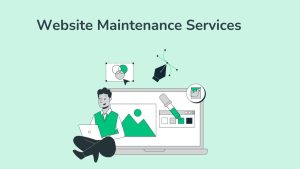In the fast-paced digital era, maintaining a website is crucial for businesses and individuals alike. A well-maintained website not only enhances user experience but also contributes to search engine rankings, security, and overall success. In this comprehensive guide, we will explore the importance of website maintenance services and delve into various aspects, including key tasks, best practices, and benefits.
1. Understanding Website Maintenance:
A. Definition and Scope: Website maintenance encompasses a range of activities aimed at keeping a website functional, secure, and up-to-date. It involves regular updates, monitoring, and troubleshooting to address potential issues and improve performance.
B. Key Components of Maintenance:
- Content Updates: Keeping website content fresh and relevant.
- Security Checks: Regular scans and updates to protect against cyber threats.
- Software Updates: Ensuring that the website’s CMS, plugins, and other software are up-to-date.
- Performance Optimization: Improving speed, responsiveness, and overall user experience.
- Backup and Recovery: Implementing robust backup systems for data protection.
2. The Importance of Website Maintenance:
A. User Experience:
- Responsive Design: Ensuring compatibility across devices for a seamless user experience.
- Content Relevance: Regular updates to engage and inform visitors.
- Speed Optimization: Enhancing loading times for improved user satisfaction.
B. Search Engine Optimization (SEO):
- Fresh Content: Regular updates contribute to higher search engine rankings.
- Technical SEO: Ensuring proper indexing, sitemap, and other technical aspects.
- Security: Search engines prioritize secure websites, impacting rankings.
C. Security and Data Protection:
- Vulnerability Mitigation: Regular updates and security patches to prevent breaches.
- Data Backups: Protecting against data loss due to unforeseen circumstances.
3. Types of Website Maintenance Services:
A. Routine Maintenance:
- Content Updates: Adding new content, updating existing pages, and refreshing images.
- Software Updates: Ensuring the CMS and plugins are running the latest versions.
- Security Audits: Regularly assessing and addressing potential vulnerabilities.
B. Emergency Maintenance:
- Quick Response: Addressing critical issues promptly to minimize downtime.
- Security Breaches: Implementing immediate measures to mitigate and recover from attacks.
C. Performance Optimization:
- Speed Improvements: Compressing images, optimizing code, and leveraging caching.
- User Experience Enhancements: Improving navigation and overall website functionality.
4. Best Practices for Effective Website Maintenance:
A. Regular Audits and Reports:
- Monitoring Tools: Using analytics and monitoring tools to track website performance.
- Reporting: Generating regular reports on traffic, security, and performance.
B. Scheduled Backup Systems:
- Automated Backups: Implementing regular, automated backups to prevent data loss.
- Off-site Storage: Storing backups in secure, off-site locations for added protection.
C. Continuous Security Measures:
- SSL Certificates: Ensuring secure connections through HTTPS.
- Firewalls and Antivirus: Implementing robust security measures to protect against threats.
D. User Feedback and Testing:
- User Testing: Collecting feedback on website usability and addressing issues.
- A/B Testing: Experimenting with different elements to optimize user engagement.
5. Benefits of Professional Website Maintenance Services:
A. Time and Resource Savings:
- Outsourcing: Allowing businesses to focus on core activities while experts manage maintenance.
- Efficiency: Professional maintenance services ensure timely and effective updates.
B. Improved Website Performance:
- Faster Loading Times: Optimizing performance for a better user experience.
- Reduced Downtime: Proactive measures to minimize disruptions and downtime.
C. Enhanced Security:
- Cyber Threat Mitigation: Regular updates and monitoring to prevent security breaches.
- Data Protection: Ensuring the safety of sensitive information through robust security measures.
Conclusion:
In conclusion, website maintenance services are an integral part of sustaining a successful online presence. Regular updates, security measures, and performance optimizations contribute to user satisfaction, improved search engine rankings, and overall business success. By understanding the importance of website maintenance and implementing best practices, businesses and individuals can ensure their websites remain effective, secure, and competitive in the ever-evolving digital landscape.




